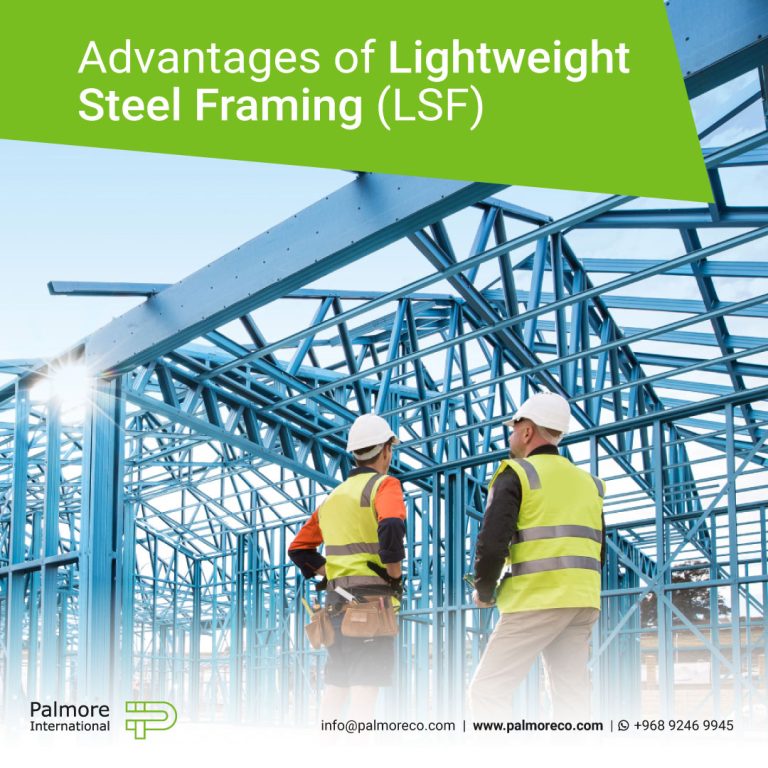
Advantages of Lightweight Steel Framing(LSF)
Lightweight metal frame structures (LSF) are a very ideal solution for professional architects due to their modular structure. Modularization of buildings is very important today in order to increase the speed of construction management, minimize debris and waste of building materials, economic savings and its visual impact from an aesthetic point of view. So that material manufacturers in developed countries in coordination with each other are modulating all building materials to follow the same modular patterns from the structure to the joinery of the building. LSF structures and in general structures that are in the form of framing (modular frames) such as wooden structures or space structures have a modular nature and have a very precise coordination with the modular design.
Some engineers and employers unfamiliar with the principles of lightweight metal frame structures (LSF) at first glance think that these types of structures due to the shape of their structures are not very compatible with a variety of indigenous architectures or different architectural styles. Most views focus on sharp corners and rough rectangular structures, and can not imagine the ultra-high flexibility of lightweight metal frame structures (LSF) for a variety of architectural styles and flexible designs with any taste.
This concern has always challenged various engineers and designers since 50 years ago to illustrate the capabilities of LSF structures by presenting a variety of designs from classical to modern architecture. The architectural flexibility of LSF structural systems in depicting a variety of architectural styles from unique and Romanesque architecture to its culmination in post-Renaissance Baroque and modern and postmodern architecture in new patterns and 21st century identities. Illustrates the architectural potential of the LSF building system in addressing all the patterns and subtleties and beauties of the various architectural styles to the highest degree so that there is no flaw in the execution of any of the various architectural style patterns and visual, aesthetic and architectural subtleties. Not seen in this system.
Advantages of LSF building system
The LSF construction system has many advantages over conventional structures such as conventional concrete and steel structures. Much easier design than other structures, prefabricated production, less execution operations, speed of installation, significant reduction of building operating costs, much less labor, reduced energy consumption, great ease of maintenance, structural stability and high seismic behavior Suitable, the ability to change and move easily in the structural and building parts, very easy demolition, complete recycling of all materials used and the absence of debris during construction and after demolition are some of the advantages of this building system; It should be noted, however, that the advantage of any phenomenon is measurable in its own right, and no phenomenon has pure benefits as it is not pure itself, and the principle of uncertainty applies to them, and their benefits are always absolute.
Economic benefits of LSF
1- Reducing the operating costs of the building due to the speed of execution
2- Reducing costs in consumables during construction
3- Reducing energy costs during the operation of the building
4- Return of capital after demolition by recycling structures and building materials
5- Reducing maintenance costs due to the convenience of service
6- Implementation and rapid arrival to the period of operation and rapid return on investment
Technical benefits of LSF
1- Very light LSF building compared to steel, concrete buildings and suitable structural behavior
2- Various executive capabilities depending on the type and conditions of the project as:
2-1- On-site construction at Stick-Built project site,
2-2- Precast Frame, Prefabricated, Panelized, Cassette
3- Modular prefabricated room, High execution speed due to being prefabricated or modular, fast operation
4- Thermal insulation of the building depending on the type and climatic conditions of the project
5- Sound insulation of the building depending on the type of design and use
6- Shelf life of the building up to 100 years due to:
6-1- Establishing structural stability conditions in natural disasters such as earthquakes and hurricanes due to lightness and high strength
6-2- Slow wear of the structure due to zinc coating 275 and 180 (G90 and G60)
6-3- To greatly reduce the fatigue of structures and buildings with structural and architectural design conditions
7- Lack of debris and deadly or harmful parts during an earthquake or building destruction
8- Lack of construction debris during the project
9- Very easy in passing and installing electrical and mechanical installations
10 – Easy access to all parts of the structure for maintenance
11- Very easy to make architectural changes and structures after operation
12- Easy control of the structure, compaction and very easy elimination of defects and defects of the structure
13- Lack of penetration of water, moisture and pests
The benefits of LSF in the path of sustainable development
1- Lack of construction debris after destruction and lack of environmental pollution
2- Creating the consumption cycle and life cycle of materials and reducing the need to produce materials from new sources
3- Reducing energy consumption and economic turnover in the production of new materials and reducing production and consumption costs
4- Reduction of atmospheric and environmental pollution caused by the production of polluting construction materials such as cement and steel
5- Elimination of water consumption and waste and effective conservation of water resources during the construction workshop
6- Increasing the life cycle and sustainable operation of the building and preserving national and financial resources

